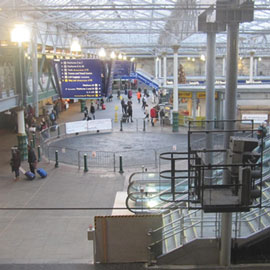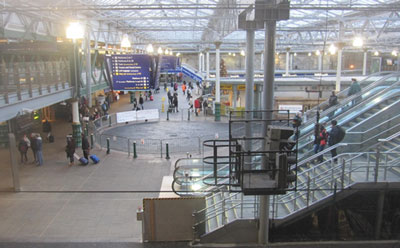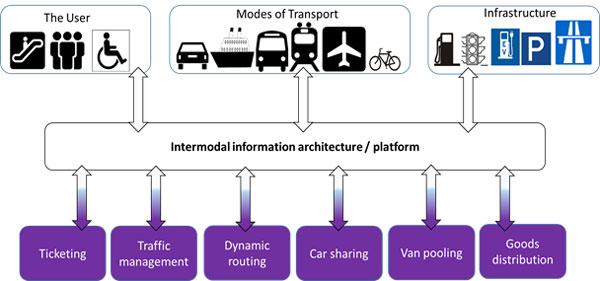Transport Intermodality: Integrated Transport for the 21st Century
- Like
- Digg
- Del
- Tumblr
- VKontakte
- Buffer
- Love This
- Odnoklassniki
- Meneame
- Blogger
- Amazon
- Yahoo Mail
- Gmail
- AOL
- Newsvine
- HackerNews
- Evernote
- MySpace
- Mail.ru
- Viadeo
- Line
- Comments
- Yummly
- SMS
- Viber
- Telegram
- Subscribe
- Skype
- Facebook Messenger
- Kakao
- LiveJournal
- Yammer
- Edgar
- Fintel
- Mix
- Instapaper
- Copy Link
Posted: 3 November 2015 | Innovate UK
Innovate UK discusses the importance of open data in establishing transport intermodality and its role in meeting the public transport demands of a technologically savvy 24/7 society. Imagine an advanced inter-connected public transport network that connects people quickly and reliably, a network that makes ticketing, routing and access to different modes of transport easier to […]


Innovate UK discusses the importance of open data in establishing transport intermodality and its role in meeting the public transport demands of a technologically savvy 24/7 society.


Edinburgh Waverly station, featuring good physical integration between pedestrian, rail and road travellers
Imagine an advanced inter-connected public transport network that connects people quickly and reliably, a network that makes ticketing, routing and access to different modes of transport easier to use than ever before, and provides reliable, predicable and accessible information to enable an informed choice of how best to reach your destination.
In today’s congested world most would agree that the movement of people and goods is one of the primary factors which plays an essential role to defining our quality of life and driving economic growth. At the same time, many would also agree that demand frequently outstrips the available capacity of our transport infrastructure. There can be few who have not experienced overcrowded trains, congested motorways or long airport delays.
Rarely does a journey use only a single mode of transport – a taxi to the station, driving to an airport, or walking to a bus-stop: these are all examples of intermodal transport, but traditionally transport providers have focused on single modes and obtaining information on how to complete the entire journey is more of a challenge to the traveller. Relying on a smart phone maps app has improved things but we’re a long way off where we need to be.
‘Society is changing, and our transport systems need to innovate to keep pace’
In the fast-paced world of technology and business the user is now placing new demands on the transport network and this is driving new challenges in how public transport meets these ever changing demands. A key consideration is that public transport is traditionally seen as being out of touch with the customer, their overall travel experience and it is not meeting expectations. Additional pressures also apply, including the fact that the travelling public now expects to be connected 24/7, and social networking and crowd sourcing are changing the landscape in how we interact with each other and the means by which we travel. Society is changing, and our transport systems need to innovate to keep pace.
Therefore, public transport suppliers are increasingly entering a new world in terms of technology, competition and demand. A basic timetable for a single part of a journey is no longer sufficient as the customer is interested in the entre journey from origin to destination. The trend toward open data platforms and the release of more and more data into the public domain is opening new opportunities for ticketing, travel route planning and financial management services. Access to open data is realising new markets in mobile applications and connected information services. What seemed impossible yesterday is now very possible with access to today’s technology and information.
In the UK, demand for transport is growing and there is every sign that this trend will continue. Overcrowded trains and congested roads are not just unpleasant travelling experiences – they also impact negatively on the economy. Increasingly, travel is now a matter of necessity, rather than something done for pleasure. The way people and businesses use transport is evolving and public transport needs to innovate to meet those changing user needs and expectations, not vice versa. Therefore, public transport needs to offer an integrated and seamless solution that fits with changing lifestyles – facilitated by emerging technologies.
Societal openness to the benefits of anonymous data sharing, open-data platforms and advanced architectures now mean that intermodal transport can better meet aspirations. Helping travellers find optimised solutions and allowing a greater choice in how they travel and use public transport. Disruptive technologies, such as the Taxi on demand mobile apps, car-sharing, van-pooling, cycle-hire and dynamic ride-sharing are now driving new business models in transport.
Innovation is the key element enabling emerging technologies for intermodal travel and collaboration is the robust component of innovation. New business and partnerships, academic relationships and new ways of working with each other is needed to achieve shared goals. Keeping momentum with today’s fast pace in business and technology means working in isolation is no longer viable. To meet these conditions many businesses are now turning towards open innovation – actively pursuing externally generated knowledge.
Open data is the cornerstone in creating transport intermodality
Concepts for intermodal travel using public transport are establishing change across other modes. The very heart of intermodal transport is open data. Understanding and monitoring the complete network of available transportation modes presents a major opportunity for the traveller and for businesses. However, to realise the benefits on offer requires each travel mode provider to make their data available to an integrator. The closer the data is to real time, the greater the value it offers the user. The challenge is merging the data from the private sector with the flood of available public data and translating it into usable and valuable information.
The development of the cloud enables ubiquitous network access to a shared pool of configurable computing resources and is driving the imagination in terms of how such systems can optimise network capacity. Therefore a capability to balance the available vehicles across the transport network for a greater overall system efficiency could now be reality. Figure 1 shows a high level platform for intermodal transport.


Figure 1 (Innovate UK)
Connecting our ports with the rail hubs, air freight and land-based distribution could offer greater efficiency in how goods and people are moved, thus reducing the cost of operation, energy consumption and vehicle ownership, and at the same time delivering greater reliability with predictability that is vital in the decision making process of the logistics value chain.
Intermodal freight transport involves the transportation of freight in an intermodal container or vehicle, using multiple modes of transportation (rail, ship, and HGV), without any handling of the freight itself when changing or interchanging modes. This provides significant advantages to industry by reducing goods handling, improving security, and reducing damage, allowing freight to be transported faster and more efficiently.
Through Innovate UK a number of key opportunities for future transport have been identified and are being driven forward. A recent Innovate UK supported project focused on developing an IT based system to connect modes and operators virtually across a number of modes and businesses, thus providing the ability to move goods by identifying transportation that has spare load capacity. This also initiates a challenge in how business-to-business goods are moved – with a focus on how a critical consignment or parcel is moved rather than the vehicle. This approach offers greater system efficiency and optimisation of freight transportation.
‘Intermodal systems also offer benefits in terms of reduced energy consumption and emissions’
Intermodal systems also offer benefits in terms of reduced energy consumption and emissions. Greater visibility of available transport capacity allows for the transport system to be used more efficiently, leading to a reduction in fuel and energy use.
Connecting weather data with traffic data can help to optimise traffic routing and reduce operational costs to traffic management organisations such as Local Authorities.
Achieving a perfect world in future transport means overcoming a series of challenges, including the lack of open data from the private sector, the variable quality of mapping data, an array of standards and interoperability issues, intellectual property, commercial collaboration plus business drivers and motivations. There can be no doubt that transport is a very complex and diverse system of systems, with complex networks influenced by perhaps the biggest variable of them all, reactive human behaviour.
Whilst we debate intermodal transport, it is worth differentiating between door-to-door services and intermodal services. Door-to-door services provide information and support to the traveller, allowing them to plan efficient journeys. Intermodal services contribute to safer, interconnected, balanced infrastructure – allowing the vehicles that move within the network to be managed more efficiently. In this context, vehicles include all those on road, rail, sea and air. The cost and environmental benefits of intermodality offer further steps towards sustainable transport.
To move transport forward for the UK, Innovate UK is investing resources to drive open innovation across a number of emerging industries and encouraging a culture of collaboration between transport providers. The longer term vision is one of harmonised intermodal transport, both public and private. Innovate UK is targeting interventions to identify user needs and drive innovation in transport, for both urban and national movement of people and goods. The future of transport in the UK is exciting but challenging. Innovate UK will continue to devise actions supporting innovation to meet these challenges.
Related topics
Business Models, Fleet Management & Maintenance, Multimodality, Ticketing & Payments, Transport Governance & Policy
Related organisations
Innovate UK








